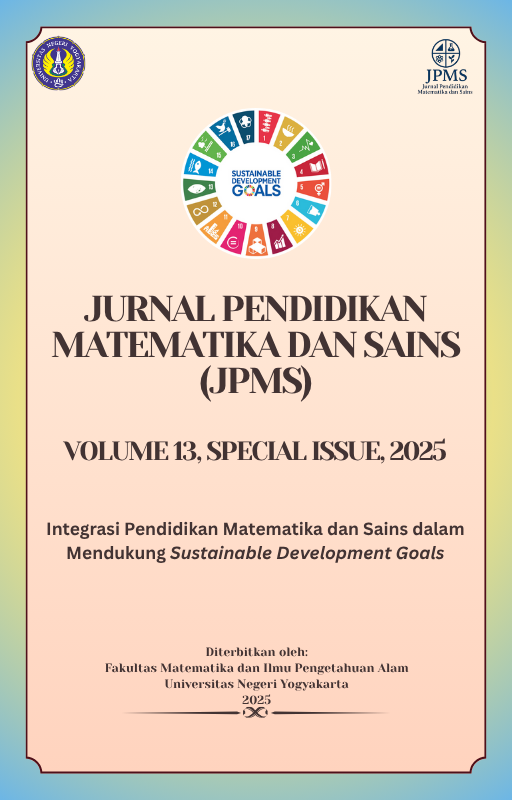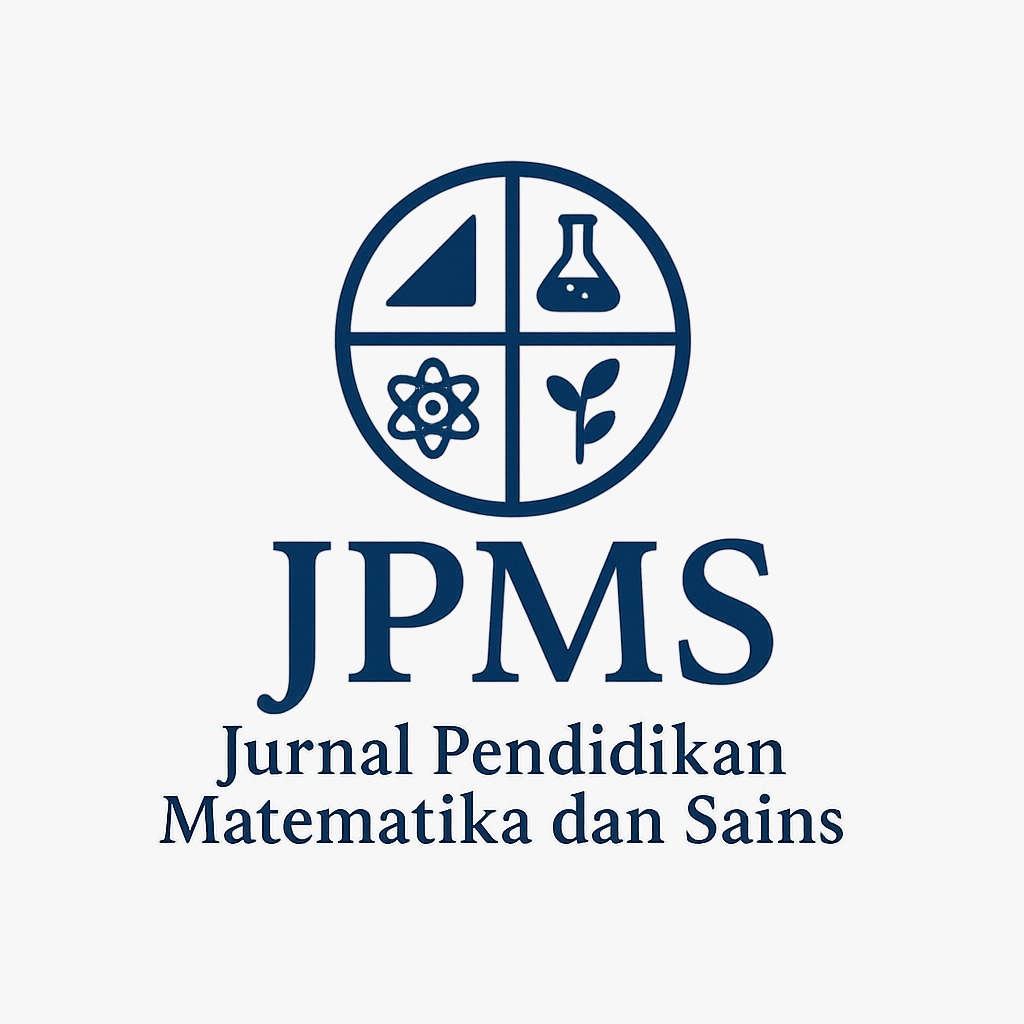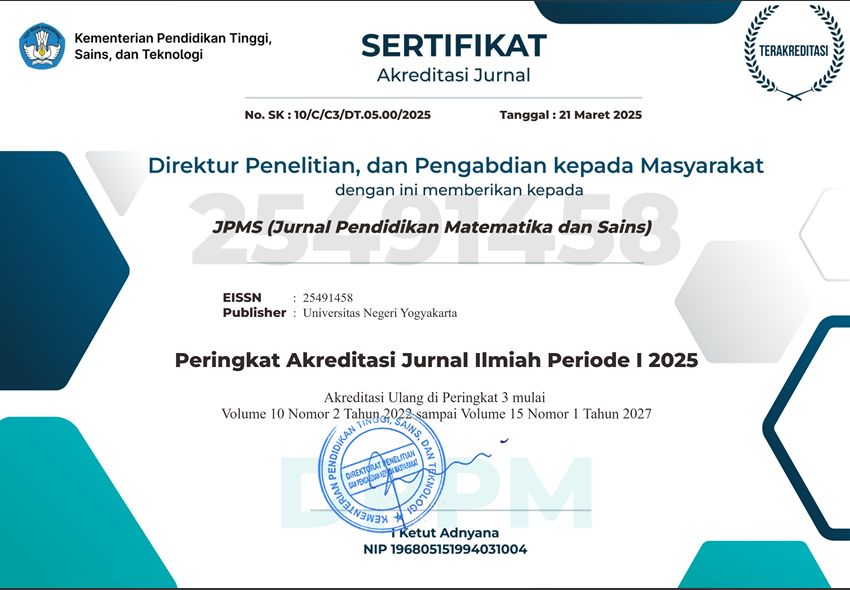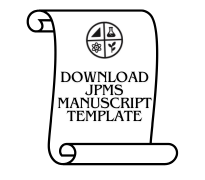High School Chemistry Learning: The Correlation Between Students' Critical Thinking and Self-Efficacy
DOI:
https://doi.org/10.21831/jpms.v13iSpecial_issue.88280Keywords:
Chemical equilibrium, Chemistry learning, Critical thinking, Self-efficacyAbstract
This study aimed to investigate the relationship between critical thinking skills and self-efficacy in high school chemistry learning. This research investigates the correlation between students' critical thinking skills and their self-efficacy. Conducted at a senior high school in Jayapura, the research involved a sample of 96 students, selected using a random sampling technique. Utilizing a quantitative approach with a correlational research design, data were collected through standardized instruments measuring students’ critical thinking and self-efficacy. The instruments used were a self-efficacy questionnaire and a critical thinking skills test in the form of open-ended two-tier multiple-choice questions. The reliability of the critical thinking test was 0.850. The validity test of the self-efficacy questionnaire showed infit and outfit MNSQ values ranging from 0.77 to 1.30 using QUEST, with a reliability coefficient of 0.71. The data were analyzed using descriptive statistics using the Pearson correlation test to determine the correlation between students’ critical thinking skills and selthe f-efficacy. The analysis revealed a significant positive correlation between the two variables, indicating that students with higher self-efficacy tend to demonstrate stronger critical thinking skills. Furthermore, the implications of this research align with the United Nations’ Sustainable Development Goals (SDG 4 on Quality Education, SDG 9 on Industry, Innovation, and Infrastructure, and SDG 12 on Responsible Consumption and Production), highlighting the contribution of chemistry education to sustainable development through enhanced critical thinking skills.
References
Armita, U. Y., & Marsigit, M. (2016). Keefektifan PBL setting STAD dan TGT ditinjau dari prestasi, berpikir kritis, dan self-efficacy. Jurnal Pendidikan Matematika dan Sains, 4(1), 1–11. https://doi.org/10.21831/jpms.v4i1.12936
Arthi, M. P., & Gandhimathi, S. (2024). Self-efficacy based instruction: Exploring the correlation between writing self-efficacy and critical thinking. World Journal of English Language, 14(6), 495–504. https://doi.org/10.5430/wjel.v14n6p495
Bandura, A. (1993). Perceived self-efficacy in cognitive development and functioning. Educational Psychologist, 28(2), 117–148. https://doi.org/10.1207/s15326985ep2802_3
Bandura, A. (1997). Self-efficacy: The exercise of control. New York: W.H. Freeman.
Casmini, N. L., Redhana, I. W., & Suma, I. K. (2024). Exploring the impact of teaching strategies on students' critical thinking skills in chemistry. Jurnal Mimbar Ilmu, 29(3), 422–431.
Changwong, K., Sukkamart, A., & Sisan, B. (2018). Critical thinking skill development: Analysis of a new learning management model for Thai high schools. Journal of International Studies, 11(2), 37–48. https://doi.org/10.14254/2071-8330.2018/11-2/3
Dehghani, M., Sani, H. J., Pakmehr, H., & Malekzadeh, A. (2011). Relationship between students’ critical thinking and self-efficacy beliefs in Ferdowsi University of Mashhad, Iran. Procedia - Social and Behavioral Sciences, 15, 2952–2955. https://doi.org/10.1016/j.sbspro.2011.04.221
Dweck, C. S., & Leggett, E. L. (1988). A social-cognitive approach to motivation and personality. Psychological Review, 95(2), 256–273. https://doi.org/10.1037/0033-295X.95.2.256
Ennis, R. H. (2011). The nature of critical thinking: An outline of critical thinking dispositions and abilities. University of Illinois.
Ennis, R. H. (2011). Critical thinking: A stream of reasoning. Pearson Education.
Facione, P. A. (2015). Critical thinking: What it is and why it counts. Insight Assessment.
Geovani, D. N., & Waluya, S. B. (2025). Systematic literature review: Pengaruh self-efficacy terhadap kemampuan berpikir kritis matematis siswa. PRISMA, Prosiding Seminar Nasional Matematika, 8, 76–84.
Gumilang, N. S. R., Wahidin, W., & Tsurayya, A. (2021). Pengembangan instrumen kemampuan berpikir kritis dan kreatif matematika peserta didik kelas VII SMP. Jurnal Pendidikan Matematika dan Sains, 9(2), 89–98. https://doi.org/10.21831/jpms.v9i2.27349
Hafizah, H., & Ramadani, Y. (2025). The effect of social simulation learning model on students' social attitudes, morality, and courtesy. Journal of Education, Teaching and Learning, 10(1). https://doi.org/10.26737/jetl.v10i1.6748
Hartanaa, A., Degeng, I. N. S., Kuswandi, D., Ulfa, S., & Mayasari, E. (2024). The influence of self-efficacy on the learning outcomes of critical thinking skills and understanding of concepts in a school-based management course. Jurnal Ilmu Pendidikan, 30(2), 98–105. https://doi.org/10.17977/um048v30i22024p098
Ijirana, Aminah, S., Supriadi, & Magfirah. (2022). Critical thinking skills of chemistry education students in team project-based STEM-metacognitive skills learning during the COVID-19 pandemic. Journal of Technology and Science Education, 12(2), 397–409. https://doi.org/10.3926/jotse.1697
Johnson, D. W., & Johnson, R. T. (1996). Cooperation and the use of technology. In D. Jonassen (Ed.), Handbook of research for educational communications and technology (pp. 785–812). Macmillan.
Kintoko, Waluya, S. B., & Asikin, M. (2023). The effect of self-efficacy on students’ critical thinking skills in mathematics subjects. In Proceedings of the 3rd UPY International Conference on Applied Science and Education (UPINCASE 2021) (pp. 249–257). AIP Publishing. https://doi.org/10.1063/5.0133313
Maddux, J. E. (2002). Self-efficacy: The power of believing you can. In C. R. Snyder & S. J. Lopez (Eds.), Handbook of positive psychology (pp. 277–287). Oxford University Press.
Misbahudin, A. R. (2019). Hubungan self-efficacy terhadap kemampuan berpikir kritis matematis siswa SMK pada materi barisan dan deret aritmatika. Journal on Education, 1(2), 445–450. https://doi.org/10.31004/joe.v1i2.86
Mishra P, Pandey CM, Singh U, Gupta A, Sahu C, Keshri A. (2019). Descriptive statistics and normality tests for statistical data. Ann Card Anaesth, 22(1), 67-72. doi: 10.4103/aca.ACA_157_18. PMID: 30648682; PMCID: PMC6350423.
Muhtadi, A., Assagaf, G., & Hukom, J. (2022). Self-efficacy and students’ mathematics learning ability in Indonesia: A meta-analysis study. International Journal of Instruction, 15(3), 1131–1146. https://doi.org/10.29333/iji.2022.15360a
Mundhofar, A. M., Issroviatiningrum, R., & Abdurrouf, M. (2025). The relationship between self-efficacy and critical thinking ability of Unissula Faculty of Nursing Science students. Journal of Nursing Invention, 6(1), 70–77. https://doi.org/10.33859/jni.v6i1.783
Nakhleh, M. B. (1992). Why some students don’t learn chemistry: Chemical misconceptions. Journal of Chemical Education, 69(3), 191–196. https://doi.org/10.1021/ed069p191
Nuraeni, Feronika, T., & Yunita, L. (2019). Implementasi self-efficacy dan keterampilan berpikir kritis siswa pada pembelajaran kimia di abad 21. Jambura Journal of Educational Chemistry, 1(2), 49–56. https://doi.org/10.34312/jjec.v1i2.2465
Omar, H. A. E.-H., & Zoube, R. R. (2024). The relationship between critical thinking skills and self-efficacy among fourth year students at the University of Jordan. Jordanian Educational Journal, 9(1), 240–264. https://doi.org/10.46515/jaes.v9i1.471
Pintrich, P. R., & De Groot, E. V. (1990). Motivational and self-regulated learning components of classroom academic performance. Journal of Educational Psychology, 82(1), 33–40. https://doi.org/10.1037/0022-0663.82.1.33
Prasetyo, B., & Wulandari, S. (2023). Enhancing students’ critical thinking through inquiry-based chemistry learning: An implementation towards SDGs. Jurnal Pendidikan Matematika dan Sains, 12(2), 112–123. https://doi.org/10.21831/jpms.v12i2.43721
Pratama, F. I., Rohaeti, E., & Laksono, E. W. (2024). Empirical foundations for developing new learning models to improve chemical literacy, scientific habits of mind, and science process skills of chemistry education students. Jurnal Penelitian Pendidikan IPA, 10(10), 8062–8069. https://doi.org/10.29303/jppipa.v10i10.8661
Pratama, F. I., Rohaeti, E., & Laksono, E. W. (2025). Building sustainable education with the literacy and research-oriented cooperative problem-based learning: A bridge in the activeness of chemistry education students. Jurnal Pendidikan Matematika dan Sains, 13(Special Issue), 61–68. https://doi.org/10.21831/jpms.v13iSpecial_issue.88392
Purwati, P., Sari, S. I., Pratama, R. A., Nikmah, F. K., & Gumintang, B. (2025). Uncovering competitive behavior: How critical thinking, self-efficacy, and social comparison shape college students in Central Java, Indonesia. The Open Psychology Journal, 18, 1–12. https://doi.org/10.2174/18743501-v18-250425
Putri, A. R., Anwar, L., Rasmiwetti, & Nursofia, Y. (2024). The influence of self-efficacy and learning independence on chemistry learning achievement: Case study in Pekanbaru. Chempublish Journal, 8(1), 43–51. https://doi.org/10.22437/chp.v8i1.32867
Rahman, A., & Lestari, D. (2024). Integrating sustainable development goals in science education: A case study in chemistry learning. Jurnal Pendidikan Matematika dan Sains, 13(1), 45–55. https://doi.org/10.21831/jpms.v13i1.4568
Raidil, M., Damris, Syahri, W., & Triansyah, F. A. (2023). Pengaruh model team assisted individualization dan self-efficacy terhadap kemampuan berpikir kritis siswa materi asam basa. Jurnal Ilmiah Ilmu Pendidikan, 6(3), 1747–1753. https://doi.org/10.5430/jiip.v6i3.1934
Riyanto, O. R., Waluya, S. B., & Mariani, S. (2020). Mathematics critical thinking reviewed from self-efficacy and motivation of learning in ARIAS learning. Journal of Primary Education, 9(2), 243–250. https://doi.org/10.15294/jpe.v9i2.35756
Rosiyanti, H., Priatna, N., & Turmudi. (2025). Self-efficacy in the context of learning strategies: A systematic literature review. Indonesian Research Journal in Education, 9(1), 347–361. https://doi.org/10.22437/irje.v9i01.440971
Saepuloh, D., Sabur, S., Lestari, S., & Mukhlishoh, S. U. (2021). Improving students' critical thinking and self-efficacy by learning higher order thinking skills through problem-based learning models. Jurnal Pendidikan Indonesia, 10(3), 495–504. https://doi.org/10.23887/jpi.v10i3.36541
Salea, N., & Soetjiningsih, C. H. (2022). Hubungan self-efficacy dengan critical thinking pada mahasiswa. Jurnal Ilmiah Bimbingan Konseling Undiksha, 13(2), 1–7. https://doi.org/10.23887/jibk.v13i2.51045
Santos, J. (2023). The role of critical thinking in science education. Journal of Education and Practice, 14(4), 15–27. https://doi.org/10.7176/JEP/14-4-03
Simorangkir, A., & Rohaeti, E. (2025). Fostering confidence in chemistry: How problem-based learning elevates self-efficacy. Jurnal Penelitian Pendidikan IPA, 13(1), 198–206. 10.21831/jpms.v13i1.84437
Simorangkir, A., & Rohaeti, E. (2019). Exploring of students’ self-efficacy: The beliefs while learning process in buffer solution. Journal of Physics: Conf. Series IOP Publishing, 1-9. doi:10.1088/1742-6596/1233/1/012017.
Sirhan, G. (2007). Learning difficulties in chemistry: An overview. Journal of Turkish Science Education, 4(2), 2–20.
Solikah, E., Utami, B., Sukarmin, & Nugrahen, F. S. A. (2023). The relationship between students’ self-efficacy and critical thinking skill in motions and forces materials. AIP Conference Proceedings, 2491(1), 1–6. https://doi.org/10.1063/5.0105930
Sutoyo, S., Sanjaya, I. G. M., Susantini, E., Cahyono, E., Abdullah, N., & Allamin, S. (2023). Improving students' critical thinking skills and self-efficacy through integrated guided inquiry with STEM. In Proceedings of the 1st Lawang Sewu International Symposium on Humanities and Social Sciences (LEWIS 2022). Atlantis Press. https://doi.org/10.2991/978-2-38476-078-7_9
Vishnumolakala, V. R., Southam, D. C., Treagust, D. F., Mocerino, M., & Qureshi, S. (2017). Students’ attitudes, self-efficacy, and experiences in a modified process-oriented guided inquiry learning undergraduate chemistry classroom. Chemistry Education Research and Practice, 18(3), 340–352. https://doi.org/10.1039/C6RP00233A
Vachova, L., Sedlakova, E., & Kvintova, J. (2023). Academic self-efficacy as a precondition for critical thinking in university students. Pegem Journal of Education and Instruction, 13(2), 328–334. https://doi.org/10.47750/pegegog.13.02.36
Wang, S.-L., & Wu, P.-Y. (2008). The role of feedback and self-efficacy on web-based learning: The social cognitive perspective. Computers & Education, 51(4), 1589–1598. https://doi.org/10.1016/j.compedu.2008.03.004
Wiśniewski, J. (2022). The Possibilities On The Use Of The Spearman Correlation Coefficient. Encyclopedia of Biostatistic).
Woldeamanuel, M. M., Atagana, H., & Engida, T. (2014). What makes chemistry difficult? African Journal of Chemistry Education, 4(2), 31–43.
Zarkasyi, C. S., & Partana, C. F. (2020). Profile of students’ self-efficacy in chemistry learning: Case study at senior high school. Journal of Physics: Conference Series, 1440, 1–6. https://doi.org/10.1088/1742-6596/1440/1/012011
Zhang, X. (2023). Exploration of a group assessment model to foster student teachers’ critical thinking. Thinking Skills and Creativity, 47, 101239. https://doi.org/10.1016/j.tsc.2022.101239
Zhou, Y., Zhu, Y., & Wong, W. K. (2023). Statistical tests for homogeneity of variance for clinical trials and recommendations. Contemporary Clinical Trials Communications, 31, 101119. https://doi.org/10.1016/j.conctc.2023.101119
Zimmerman, B. J. (2000). Self-efficacy: An essential motive to learn. Contemporary Educational Psychology, 25(1), 82–91. https://doi.org/10.1006/ceps.1999.1016
Downloads
Published
How to Cite
Issue
Section
Citation Check
License

This work is licensed under a Creative Commons Attribution-ShareAlike 4.0 International License.
Jurnal Pendidikan Matematika dan Sains allows readers to read, download, copy, distribute, print, search, or link to its articles' full texts and allows readers to use them for any other lawful purpose. The journal allows the author(s) to hold the copyright without restrictions. Finally, the journal allows the author(s) to retain publishing rights without restrictions
- Authors are allowed to archive their submitted article in an open access repository
- Authors are allowed to archive the final published article in an open access repository with an acknowledgment of its initial publication in this journal

This work is licensed under a Creative Commons Attribution-ShareAlike 4.0 Generic License.





